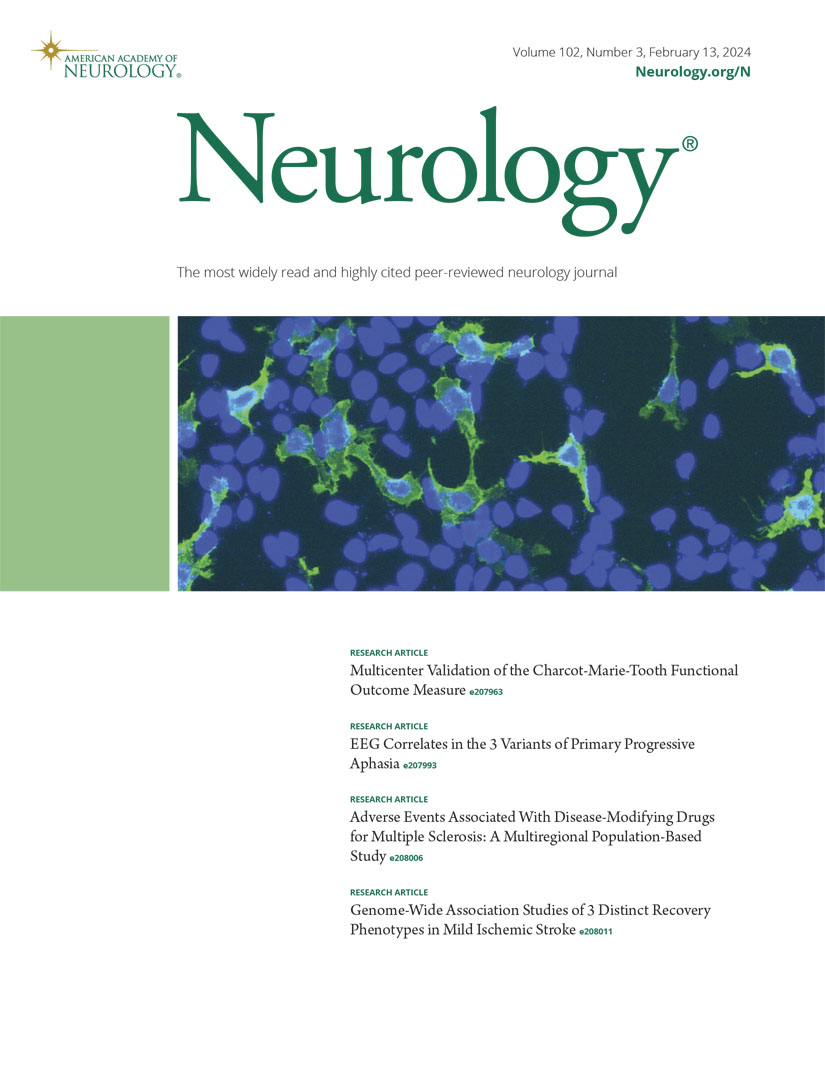Automated Speech Analysis to Differentiate Frontal and Right Anterior Temporal Lobe Atrophy in Frontotemporal Dementia.
IF 7.7
1区 医学
Q1 CLINICAL NEUROLOGY
引用次数: 0
Abstract
BACKGROUND AND OBJECTIVES Frontotemporal dementia (FTD) includes behavioral-variant FTD (bvFTD) with predominant frontal atrophy and semantic behavioral-variant FTD (sbvFTD) with predominant right anterior temporal lobe (rATL) atrophy. These variants present diagnostic challenges because of overlapping symptoms and neuroanatomy. Accurate differentiation is crucial for clinical trial inclusion targeting TDP-43 proteinopathies. This study investigated whether automated speech analysis can distinguish between FTD-related rATL and frontal atrophy, potentially offering a noninvasive diagnostic tool. METHODS This cross-sectional study used data from the University of California, San Francisco Memory and Aging Center. Using stepwise logistic regression and receiver-operating characteristic curve analysis, we analyzed 16 linguistic and acoustic features that were extracted automatically from audio-recorded picture description tasks. Voxel-based morphometry was used to investigate brain-behavior relationships. RESULTS We evaluated 62 participants: 16 with FTD-related predominant frontal atrophy, 24 with predominant rATL atrophy, and 22 healthy controls (mean age 68.3 years, SD = 9.2; 53.2% female). Logistic regression identified 3 features (content units, lexical frequency, and familiarity) differentiating the overall FTD group from controls (area under the curve [AUC] = 0.973), adjusted for age. Within the FTD group, 5 features (adpositions/total words ratio, arousal, syllable pause duration, restarts, and words containing "thing") differentiated frontal from rATL atrophy (AUC = 0.943). Neuroimaging analyses showed that semantic features (lexical frequency, content units, and "thing" words) were linked to bilateral inferior temporal lobe structures, speech and lexical features (syllable pause duration, and adpositions/total words ratio) to bilateral inferior frontal gyri, and socioemotional features (arousal) to areas known to mediate social cognition including the right insula and bilateral anterior temporal structures. As a composite score, this set of 5 features was uniquely associated with rATL atrophy. DISCUSSION Automated speech analysis demonstrated high accuracy in differentiating FTD subtypes and provided insights into the neural basis of language impairments. Automated speech analysis could enhance early diagnosis and monitoring of FTD, offering a scalable, noninvasive alternative to traditional methods, particularly in resource-limited settings. Future research should focus on further clinical validation with other neuroimaging or fluid biomarkers and longitudinal cognitive data, as well as external validation in larger and more diverse populations.自动语音分析用于区分额颞叶痴呆患者额颞叶萎缩和右颞叶萎缩。
背景与目的额颞叶痴呆(FTD)包括以额叶萎缩为主的行为变异性额颞叶痴呆(bvFTD)和以右颞叶萎缩为主的语义性行为变异性额颞叶痴呆(sbvFTD)。由于症状和神经解剖学的重叠,这些变异给诊断带来了挑战。准确的分化对于TDP-43蛋白病变的临床试验纳入至关重要。本研究调查了自动语音分析是否可以区分ftd相关的rATL和额叶萎缩,可能提供一种无创诊断工具。方法本横断面研究使用来自加州大学旧金山记忆与衰老中心的数据。利用逐步逻辑回归和接收机操作特征曲线分析,我们分析了从录音图像描述任务中自动提取的16个语言和声学特征。使用基于体素的形态测量法研究脑-行为关系。结果我们评估了62名参与者:16名患有ftd相关的主要额叶萎缩,24名患有主要的rATL萎缩,22名健康对照(平均年龄68.3岁,SD = 9.2;53.2%的女性)。Logistic回归确定了3个特征(内容单位、词汇频率和熟悉度),将整个FTD组与对照组区分开来(曲线下面积[AUC] = 0.973),并根据年龄进行了调整。在FTD组中,5个特征(副词/总词比、觉醒、音节停顿时间、重启和含有“thing”的词)区分了额叶和rATL萎缩(AUC = 0.943)。神经成像分析显示,语义特征(词汇频率、内容单位和“事物”词)与双侧下颞叶结构有关,言语和词汇特征(音节停顿时间、副词/总单词比例)与双侧额叶下回有关,社会情绪特征(唤醒)与介导社会认知的区域有关,包括右脑岛和双侧颞叶前部结构。作为一个综合评分,这组5个特征与rATL萎缩唯一相关。自动语音分析在区分FTD亚型方面显示出很高的准确性,并为语言障碍的神经基础提供了见解。自动化语音分析可以加强FTD的早期诊断和监测,为传统方法提供了一种可扩展的、无创的替代方法,特别是在资源有限的环境中。未来的研究应侧重于进一步的临床验证,包括其他神经影像学或液体生物标志物和纵向认知数据,以及在更大、更多样化的人群中进行外部验证。
本文章由计算机程序翻译,如有差异,请以英文原文为准。
求助全文
约1分钟内获得全文
求助全文
来源期刊

Neurology
医学-临床神经学
CiteScore
12.20
自引率
4.00%
发文量
1973
审稿时长
2-3 weeks
期刊介绍:
Neurology, the official journal of the American Academy of Neurology, aspires to be the premier peer-reviewed journal for clinical neurology research. Its mission is to publish exceptional peer-reviewed original research articles, editorials, and reviews to improve patient care, education, clinical research, and professionalism in neurology.
As the leading clinical neurology journal worldwide, Neurology targets physicians specializing in nervous system diseases and conditions. It aims to advance the field by presenting new basic and clinical research that influences neurological practice. The journal is a leading source of cutting-edge, peer-reviewed information for the neurology community worldwide. Editorial content includes Research, Clinical/Scientific Notes, Views, Historical Neurology, NeuroImages, Humanities, Letters, and position papers from the American Academy of Neurology. The online version is considered the definitive version, encompassing all available content.
Neurology is indexed in prestigious databases such as MEDLINE/PubMed, Embase, Scopus, Biological Abstracts®, PsycINFO®, Current Contents®, Web of Science®, CrossRef, and Google Scholar.
 求助内容:
求助内容: 应助结果提醒方式:
应助结果提醒方式:


